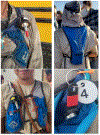Concurrent Particulate Matter and Heat Exposure in Working and Non-working Women in Rural Guatemala
- PMID: 40980702
- PMCID: PMC12448059
- DOI: 10.3390/atmos15101175
Concurrent Particulate Matter and Heat Exposure in Working and Non-working Women in Rural Guatemala
Abstract
High temperatures and air pollution exposure are individually known risks to human health, with amplifying adverse health effects during periods of co-exposure. This study compared co-occurring individual-level exposures to particulate matter (PM5, aerodynamic diameter of ≤ 5 micrometers) and heat among women in residential and agricultural settings in Guatemala. We measured personal and ambient exposure to PM5, temperature, and humidity among 21 female sugarcane workers in the fields and on their off days. We measured similar exposures among a group of 30 community members not involved in sugarcane work. We collected 171 personal PM5 measurements across 18 sampling days. The median workday personal PM5 concentration was 271 μg/m3, which was 3.6-fold higher than ambient area levels in the fields. The median personal PM5 concentration was 95.8 ug/m3 for off-work days and 83.5 ug/m3 for community days. The average workday individual-level temperature and humidity were 39.4°C and 82.4%, respectively, with significantly lower temperatures on off-work and community days. The women workers and community members were exposed to high levels of PM5 and heat in both occupational and residential settings. Research needs to consider individual-level exposures at both work and home to help tailor more effective comprehensive prevention efforts to reduce risks.
Keywords: Agricultural Workers; Environmental Exposures; Heat; Particulate Matter; Women.
Conflict of interest statement
Competing Interests: The authors declare they have no actual or potential competing financial interests.
Figures




References
-
- Sarofim MC, Saha S, Hawkin MD, Mills DM, Hess J, Horton R, et al. Ch. 2: Temperature-Related Death and Illness. The Impacts of Climate Change on Human Health in the United States: A Scientific Assessment U.S. Global Change Research Program, Washington: 2016. [cited 2023. Available from: 10.7930/J0MG7MDX. - DOI
-
- Reidmiller DR, Avery CW, Easterling DR, Kunkel KE, Lewis KLM, Maycock TK, et al. Impacts, Risks, and Adaptation in the United States: Fourth National Climate Assessment, Volume II: Report-in-Brief. U.S. Global Change Research Program, Washington, DC, USA; 2018.
-
- Crimmins A, Balbus J, Gamble JL, Beard CB, Bell JE, Dodgen D, Eisen RJ, Fann N, Hawkins MD, Herring SC, Jantarasami L, Mills DM, Saha S, Sarofim MC, Trtanj J, and Ziska L. Ch. 9: Populations of concern. In: The impacts of climate change on human health in the United States: A scientific assessment. U.S. Global Change Research Program. In: Program USGCR, editor. Washington D.C. 2016.
-
- World Health Organization. Africa Region: Air Pollution. 2023. Available from: Air Pollution | WHO | Regional Office for Africa
-
- Kjellstrom T, Holmer I, Lemke B. Workplace heat stress, health and productivity - an increasing challenge for low and middle-income countries during climate change. Global health action. 2009;2: 10.3402/gha.v2i0.2047. - DOI
Grants and funding
LinkOut - more resources
Full Text Sources
